Influence of Measurement Aggregation Algorithms on Power Quality Assessment and Correlation Analysis in Electrical Power Network with PV Power Plant
Abstract
:1. Introduction
- Article [5] looks at the time varying nature of the PQ distortion level caused by different working conditions of the load demand as well as energy production delivered to the mining electrical power network by distributed generation.
- Article [6] presents and discusses the behavior of the voltage in the Algerian Low-Voltage distribution network and the influence of the PV generation. The assessment is based on PQ analysis according to EN 50160 and IEC 61000-2-2 standards. The standard EN 50160:2011 was used.
- Paper [7] presents a photovoltaic (PV) system with an uninterruptible power supply (UPS), equipped with energy storage (25 kWh) and a system for monitoring and management of energy flow. It contains the analysis of energy quality measurements carried out at a point where the PV system is connected to the power grid. The assessment is based on PQ analysis according to EN 50160 and country regulation—Instructions for Distribution Network Traffic and Exploitation applicable since 1 January, 2014, TAURON Dystrybucja S.A. The standard EN 50160:2011 was used.
- Article [8] describes possible adverse effects of the source on the power network parameters while meeting the conditions contained in the applicable standards and regulations. The presented documents are EN 50160:2011, VDE-AR-N-4105, EN 61000-2-2, Polish Regulation of the Minister of Economy of 2007-05-01, Polish Instructions of traffic and operation in distribution networks (network code).
- Article [9] contains the investigation of the effects of a high-power installed photovoltaic on a rural LV grid. Additionally, the paper presents the comparison of different measures from a technical perspective. The article analysis is based on EN 50160:2011.
- Article [10] describes a study of the rapid voltage change. It is realized by modelling the moving cloud shadow and compares the hosting capacity (HC) from the perspective of both dynamic and static characteristics. The article indicates the requirements for a static characteristic based on 10 min on the basis of EN 50160:2011.
- Article [11] presents a model of a selected part of a distribution network. The model was created in Matlab/Simulink, based on real data, and the impact of PV power plants on voltage amplitude in accordance with EN 50160:2011. The measurement data are based on 1 week in summer.
- Article [12] deals with impact of two PV plants with equal characteristics. The first is strongly connected (urban area) and second one is weakly connected (rural area) to the distribution grid at the PCC. The PQ demands are based on EN 50160:2011.
- Paper [13] contains research on the impact of the aggregation interval (1 min, 10 min, 30 min), aggregation method (mean, max) and assessment quantiles (95%, 99%) on voltage quality parameters. The considered parameters are voltage magnitude, selected harmonics, total harmonic distortion index and unbalance. The research is based on a database of measurements performed in public low voltage grids. The article conclusion indicates that a higher aggregation interval usually results in a less dynamic time series with a smaller variation range, however for the investigated measurement data no significant influence of the calculation parameters on the results could be identified. Some negligible maximum absolute deviation has been observed for different aggregation intervals. Similar analysis of the aggregation impact is presented in paper [14] and the obtained results are similar. However, both papers have recommended a further verification of the results for grids with a significantly different structure. This recommendation was a motivation for the presented paper. That is why this paper is focused on the investigation of the possible impact of the aggregation interval on power quality assessment in a particular case of the point of common coupling of a photovoltaic plant when the variability of the parameters is more expected.
2. Comparative Study of Recent Developments in Power Quality Requirements
3. Description of Investigated PV Power Plant
- First generation—silicon cells, from crystalline silicon:
- ○
- Monocrystalline (sc-Si) (yellow),
- ○
- Multicrystalline (mc-Si) (orange),
- Second generation—thin-film cells:
- ○
- Cadmium telluride cells (CdTe) (pink),
- ○
- Burns from CuInGaSe2 copper-indium selenide (Copper-Indium-Gallium-Diselenide—CIGS) (green).
- Air pressure, AtmP
- Ambient temperature, Ta
- Relative humidity, RH
- Wind speed, WS
- Global horizontal irradiance, Gh
- Diffuse horizontal irradiance, Gd
4. Results of the PQ Assessment and Correlation Analysis for Different Aggregation Time Intervals
4.1. General Comparison of the PQ Assessment Results Using Requirements of EN 50160:2010 and EN 50160:2015
4.2. Voltage Variation Analysis Using 1 Min and 10 Min Aggregation Intervals
- the mean value is the same for 1 min and 10 min aggregation intervals;
- extreme values are higher for the 1 min aggregation interval;
- variation and standard deviation are higher for the 1 min aggregation interval;
- the median value is very similar for both the 1 min and 10 min aggregation intervals.
- high level of irradiance (12 July, 2018 12:00) Gh = 759 W/m2
- low level of irradiance (17 July, 2018 12:00) Gh = 172 W/m2
4.3. Correlation Analysis Using 1 Min and 10 Min Aggregation Intervals
- strong correlation between global horizontal irradiance intensity (Gh) and active power (P) with an extremal value equal to 0.99;
- high correlation between intensity of the diffuse horizontal irradiance component (Gd) and active power (P) with an extremal value equal to 0.72;
- noticeable correlation between ambient temperature (Ta) and voltage variation (U) with qn extremal value equal to 0.62, total harmonic distortion in voltage (THDu) with an extremal value equal to −0.55 and active power (P) with an extremal value equal to 0.63;
- noticeable correlation between relative humidity (RH) and voltage variation (U) with an extremal value equal to −0.60, total harmonic distortion in voltage (THDu) with an extremal value equal to 0.45, active power (P) with an extremal value equal to −0.60;
- noticeable correlation between global horizontal irradiance intensity (Gh) and total harmonic distortion in voltage (THDu) with an extremal value equal to −0.58;
- noticeable correlation between intensity of the diffuse horizontal irradiance component (Gd) and short-term flicker severity (Pst) with an extremal value equal to 0.44;
- strong correlation between the line-to-line values of three-phase parameters (U, Pst, THDu, P) with a minimal value equal to 0.90;
- noticeable correlation between L1 voltage variations (U) and L1, L2, L3 active power (P) with an extremal value equal to 0.48;
- noticeable correlation between L2 and L3 voltages variations (U) and L2 and L3 short-term flicker severities (Pst) with an extremal value equal to −0.47;
- noticeable correlation between short-term flicker severities (Pst) and total harmonic distortion in voltage (THDu) with an extremal value equal to −0.49;
- noticeable correlation between total harmonic distortion in voltage (THDu) and active power (P) with an extremal value equal to −0.59;
- other correlations are too low to be noticeable.
5. Discussions
6. Conclusions
Author Contributions
Funding
Acknowledgments
Conflicts of Interest
Abbreviations
| AC | alternative current |
| AtmP | air pressure |
| CC | connector cable |
| CdTe | Cadmium telluride cells |
| CIGS | Copper-Indium-Gallium-Diselenide |
| DC | direct current |
| EN | European Standard |
| f | frequency variation |
| Gd | intensity of the scattered radiation component |
| Gh | total horizontal radiation intensity |
| HC | host capacity |
| IEC | International Electrotechnical Commission |
| IEEE | Institute of Electrical and Electronics Engineers |
| ku2 | asymmetry |
| mc-Si | multicrystalline |
| MS | measuring system |
| MSS | main switching station |
| P | active power change |
| Plt | long-term flicker severity |
| Pst | short-term flicker severity |
| PVFS | PV Solar Farm |
| PVSS | photovoltaic switching station |
| RES | renewable energy sources |
| RH | relative humidity |
| sc-Si | monocrystalline |
| Ta | ambient temperature |
| THD | total harmonic distortion |
| U | voltage variation |
| VDE | Verband der Elektrotechnik, Elektronik und Informationstechnik |
| WS | wind speed |
References
- EN 50160: Voltage Characteristics of Electricity Supplied by Public Distribution Network; PKN: Warszawa, Polska, 2010.
- EN 50160: Voltage Characteristics of Electricity Supplied by Public Distribution Network; PKN: Warszawa, Polska, 2015.
- IEC 61000 4–30 Electromagnetic Compatibility (EMC)—Part 4–30: Testing and Measurement Techniques—Power Quality Measurement Methods; PKN: Warszawa, Polska, 2015.
- IEEE. Monitoring and Definition of Electric Power Quality; IEEE: Piscataway Township, NJ, USA, 2009. [Google Scholar]
- Jasiński, M.; Sikorski, T.; Borkowski, K. Clustering as a tool to support the assessment of power quality in electrical power networks with distributed generation in the mining industry. Electr. Power Syst. Res. 2019, 166, 52–60. [Google Scholar] [CrossRef]
- Bouchakour, S.; Arab, A.H.; Abdeladim, K.; Amrouche, S.O.; Semaoui, S.; Taghezouit, B.; Boulahchiche, S.; Razagui, A. Investigation of the voltage quality at PCC of grid connected PV system. Energy Procedia 2017, 141, 66–70. [Google Scholar] [CrossRef]
- Gała, M.; Jąderko, A. Assessment of the impact of photovoltaic system on the power quality in the distribution network. Prz. Elektrotech. 2018, 94, 162–165. [Google Scholar] [CrossRef]
- Grycan, W.; Brusilowicz, B.; Kupaj, M. Photovoltaic farm impact on parameters of power quality and the current legislation. Sol. Energy 2018, 165, 189–198. [Google Scholar] [CrossRef]
- Bogenrieder, J.; Glass, O.; Luchscheider, P.; Stegner, C.; Weller, J. Technical comparison of measures for voltage regulation in low-Voltage grids. In Proceedings of the 24th International Conference on Electricity Distribution, Glasgow, UK, 12–15 June 2017; pp. 1–5. [Google Scholar]
- Divshali, P.H.; Soder, L. Improving PV hosting capacity of distribution grids considering dynamic voltage characteristic. In Proceedings of the Power Systems Computation Conference (PSCC), Dublin, Ireland, 11–15 June 2018. [Google Scholar]
- Vojtek, M.; Kolcun, M.; Špes, M. Utilization of energy storages in low voltage grids with high penetration of photovoltaics—Addressing voltage issues. In Proceedings of the 2018 19th International Scientific Conference on Electric Power Engineering (EPE), Brno, Czech Republic, 16–18 May 2018. [Google Scholar]
- Ramljak, I.; Ramljak, I. PV plant connection in urban and rural LV grid: Comparison of voltage quality results. In Advanced Technologies, Systems, and Applications III; Springer: Berlin, Germany, 2018; pp. 271–278. [Google Scholar]
- Meyer, J.; Domagk, M.; Darda, T.; Eberl, G. Influence of aggregation intervals on power quality assessment according to EN 50160. In Proceedings of the 22nd International Conference and Exhibition on Electricity Distribution (CIRED 2013), Institution of Engineering and Technology, Stockholm, Sweden, 10–13 June 2013; p. 1174. [Google Scholar]
- Elphick, S.; Gosbell, V.; Perera, S. The effect of data aggregation interval on voltage results. In Proceedings of the 2007 Australasian Universities Power Engineering Conference, Perth, Australia, 9–12 December 2007; pp. 1–7. [Google Scholar]
- Jasiński, M.; Rezmer, J.; Sikorski, T.; Szymańda, J. Integration Monitoring of On-Grid Photovoltaic System: Case Study. Period. Polytech. Electr. Eng. Comput. Sci. 2019, 63, 99–105. [Google Scholar] [CrossRef]
- Statsoft Polska StatSoft Electronic Statistic Textbook. Available online: http://www.statsoft.pl/textbook/ stathome.html (accessed on 15 February 2019).
- Sikorski, T. Monitoring i Ocena Jakości Energii w Sieciach Elektroenergetycznych z Udziałem Generacji Rozproszonej; Oficyna Wydawnicza Politechniki Wrocławskiej: Wroclaw, Poland, 2013. (In Polish) [Google Scholar]
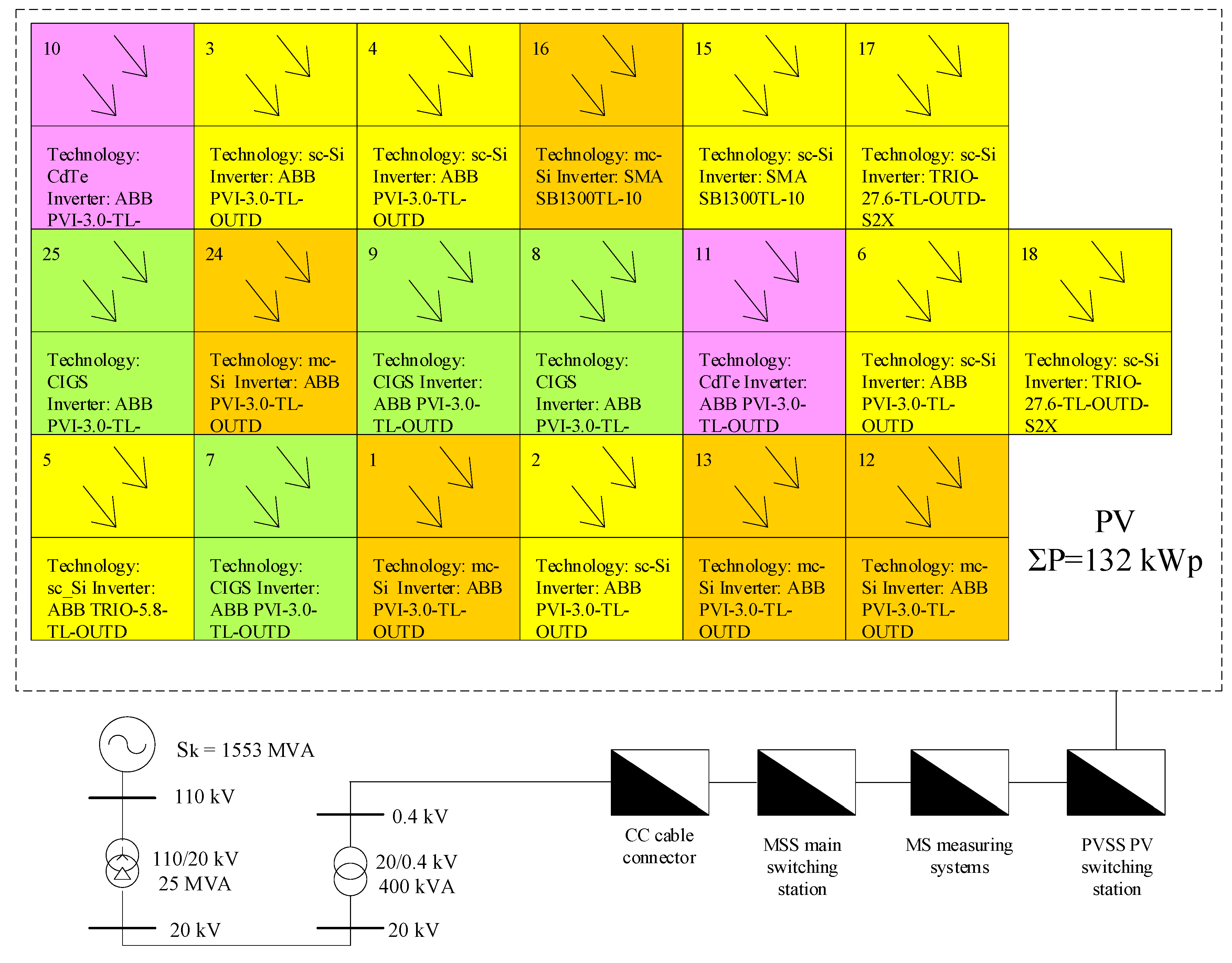
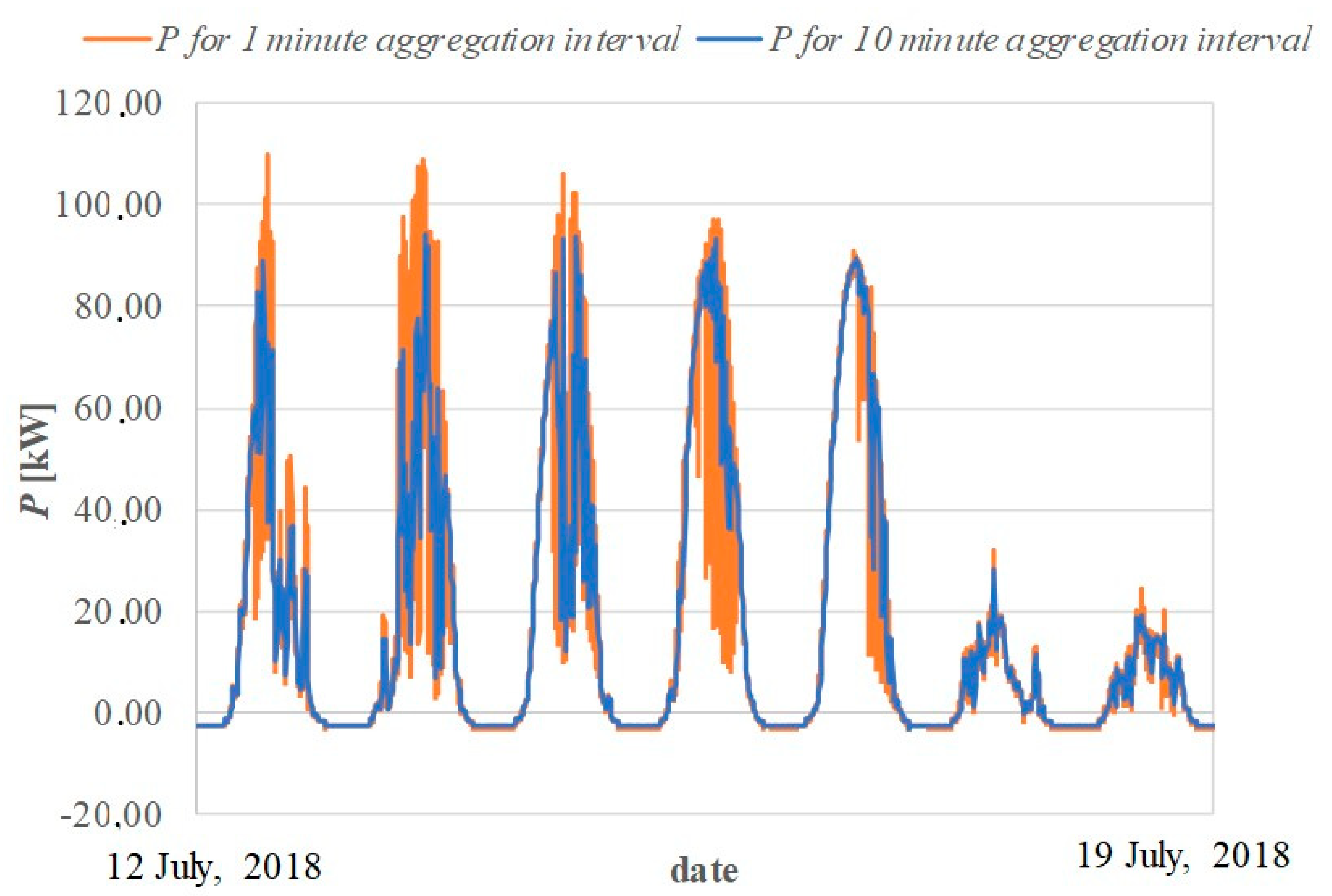
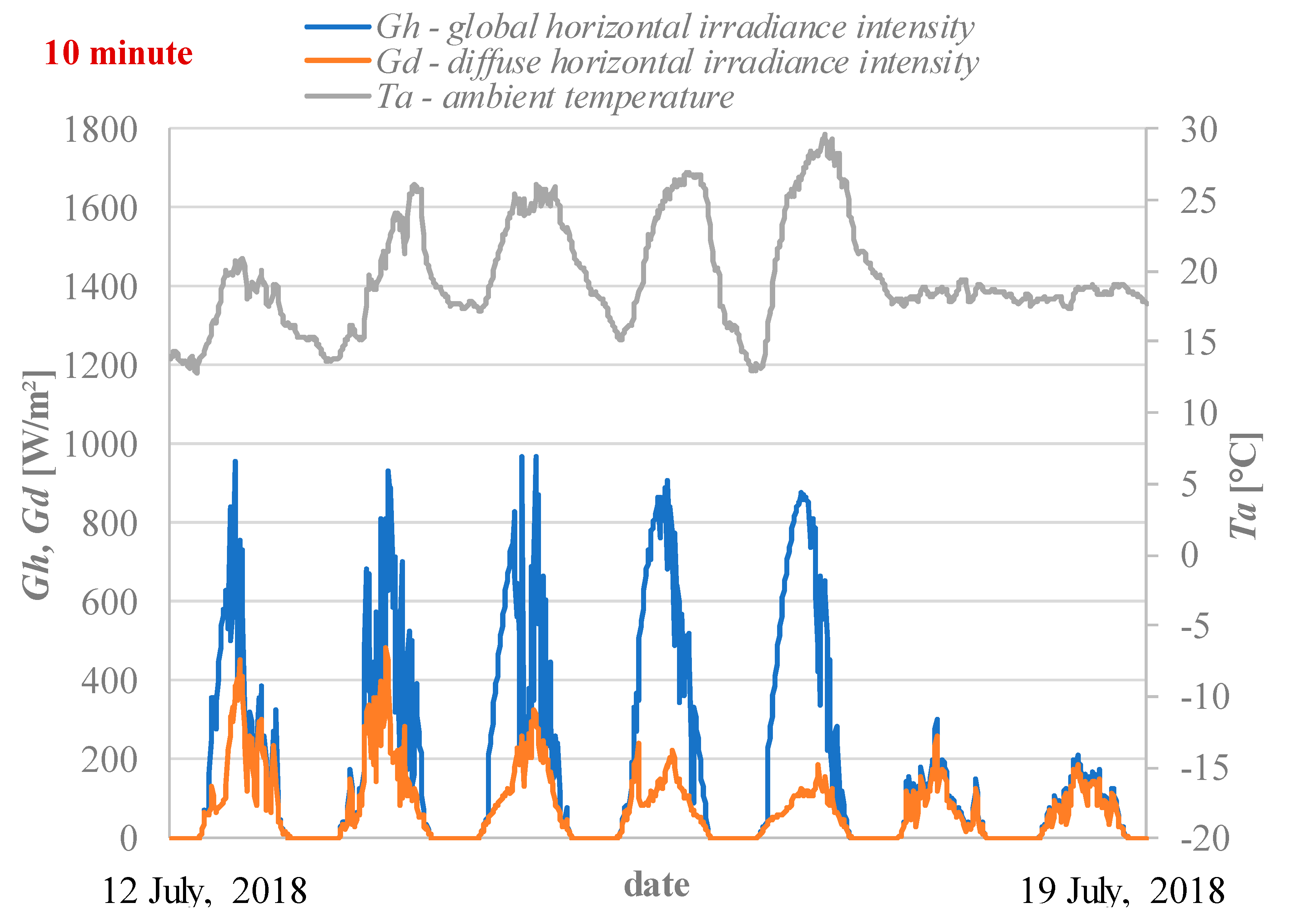
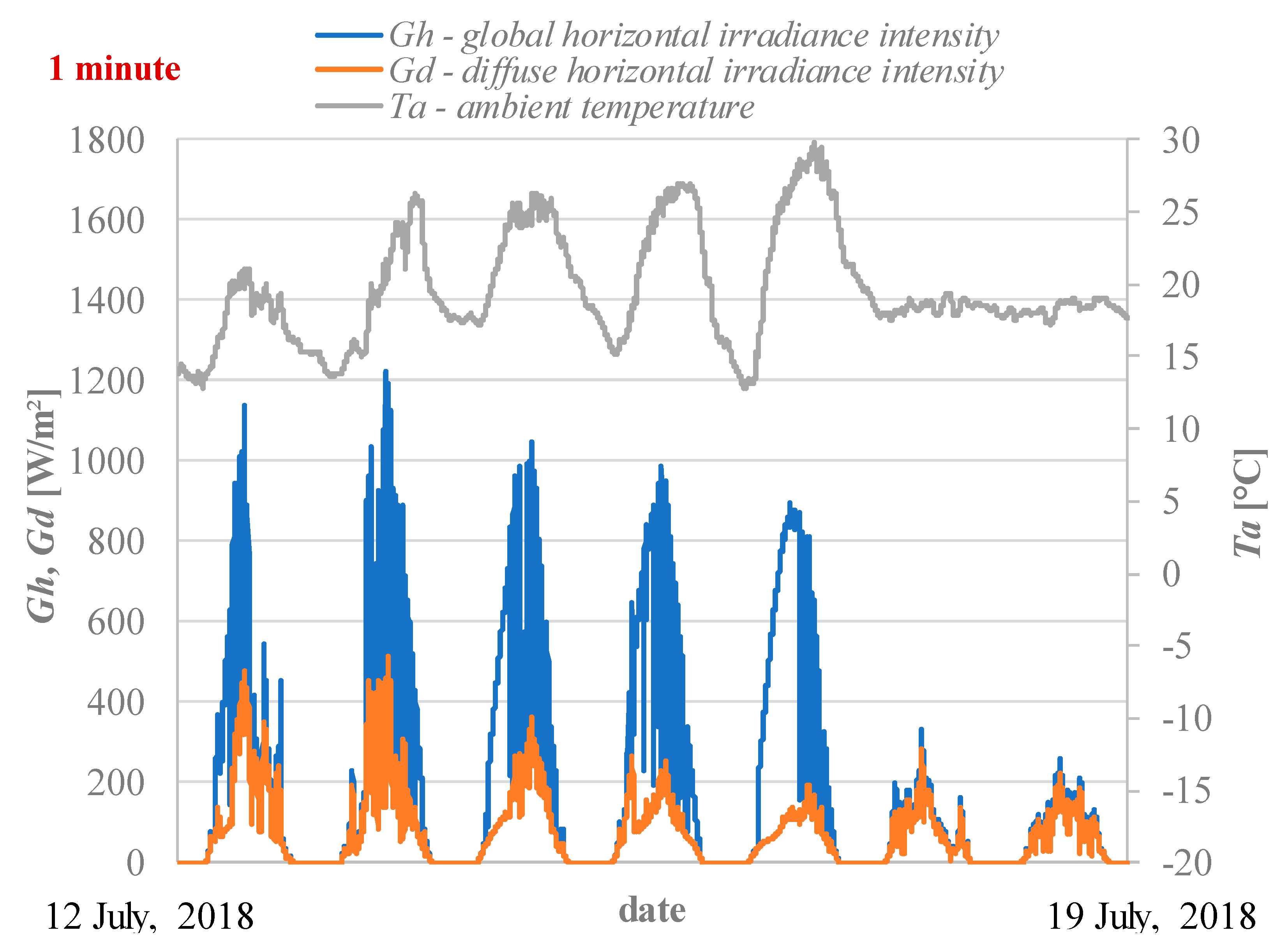
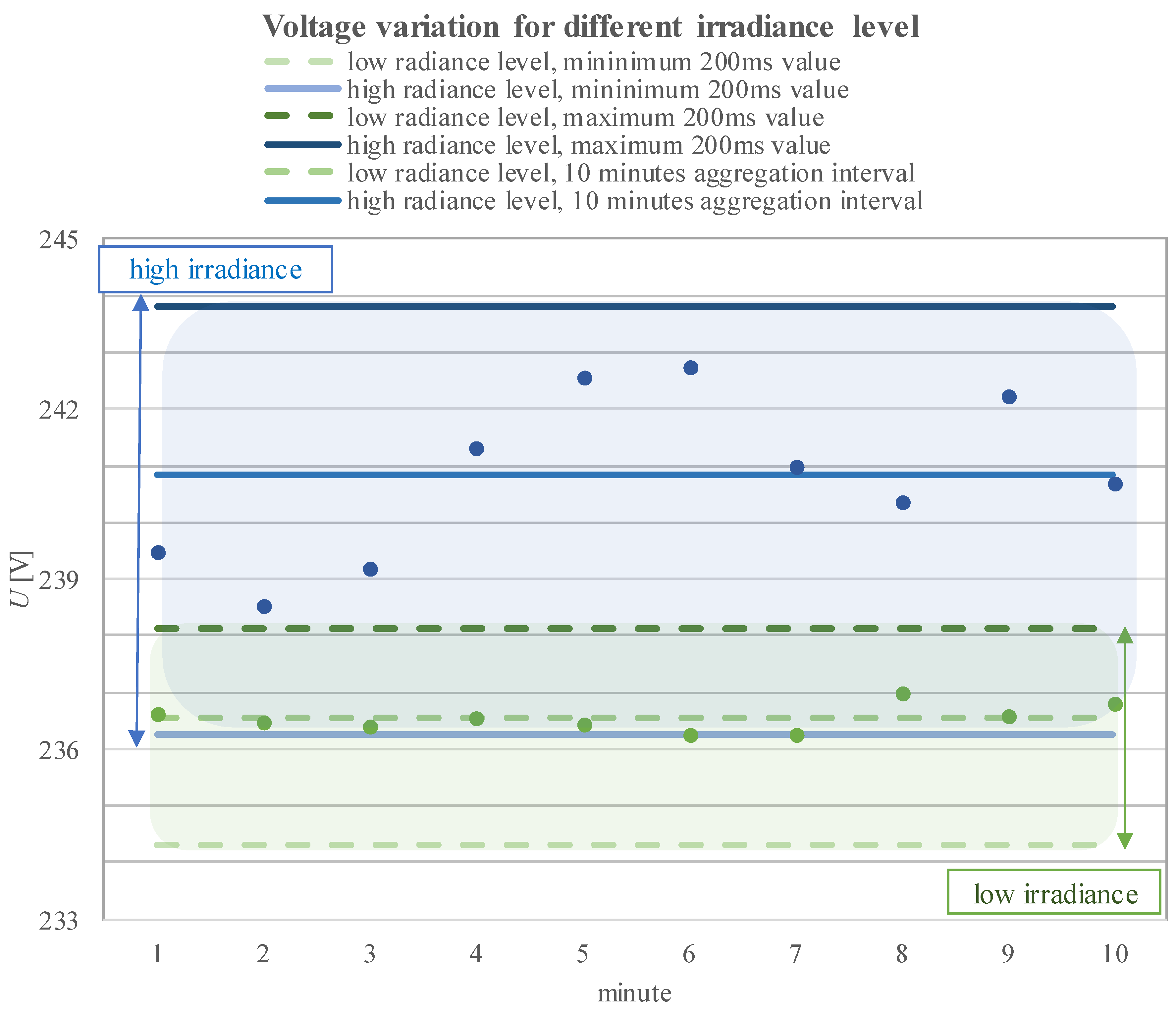
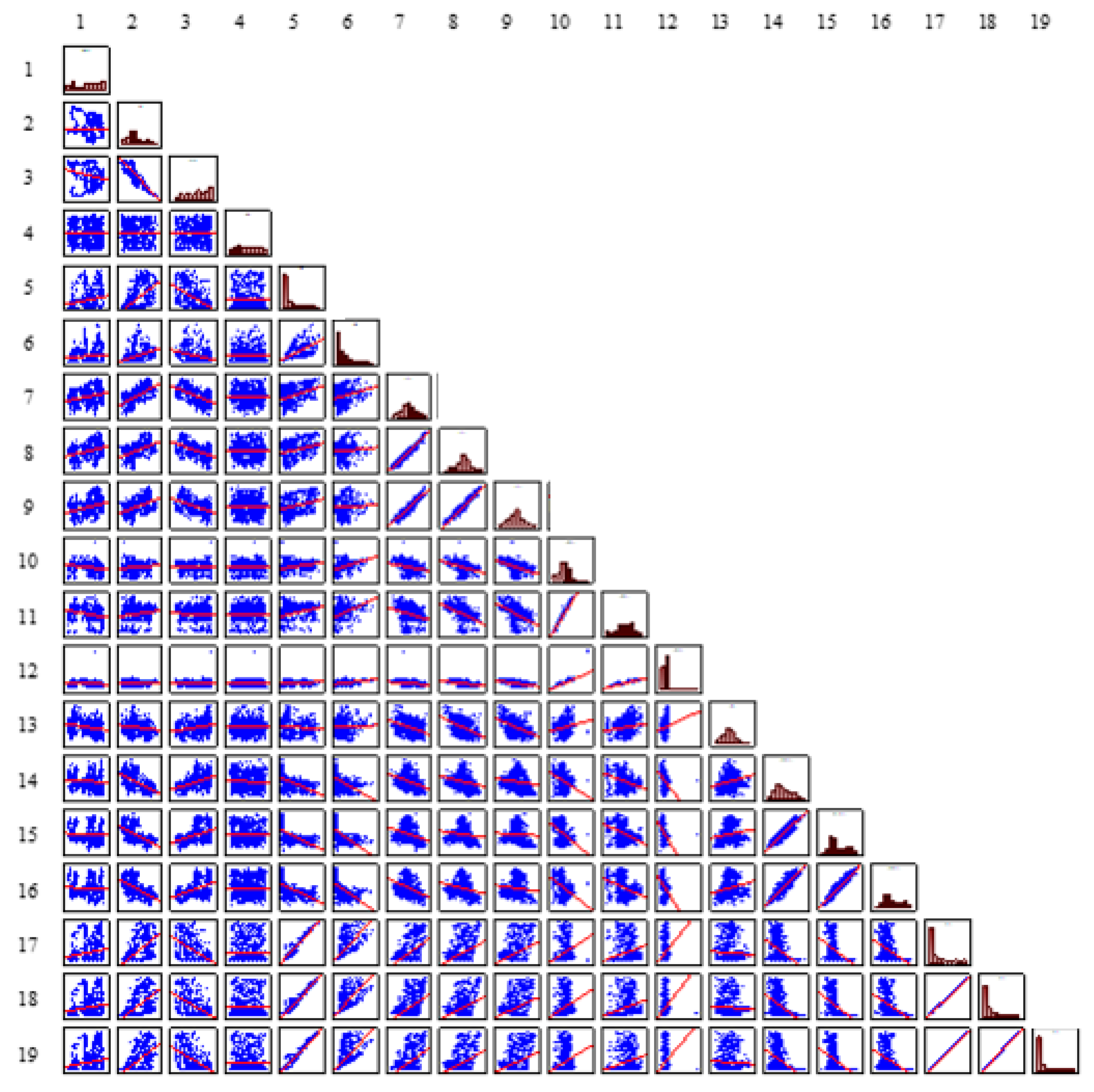
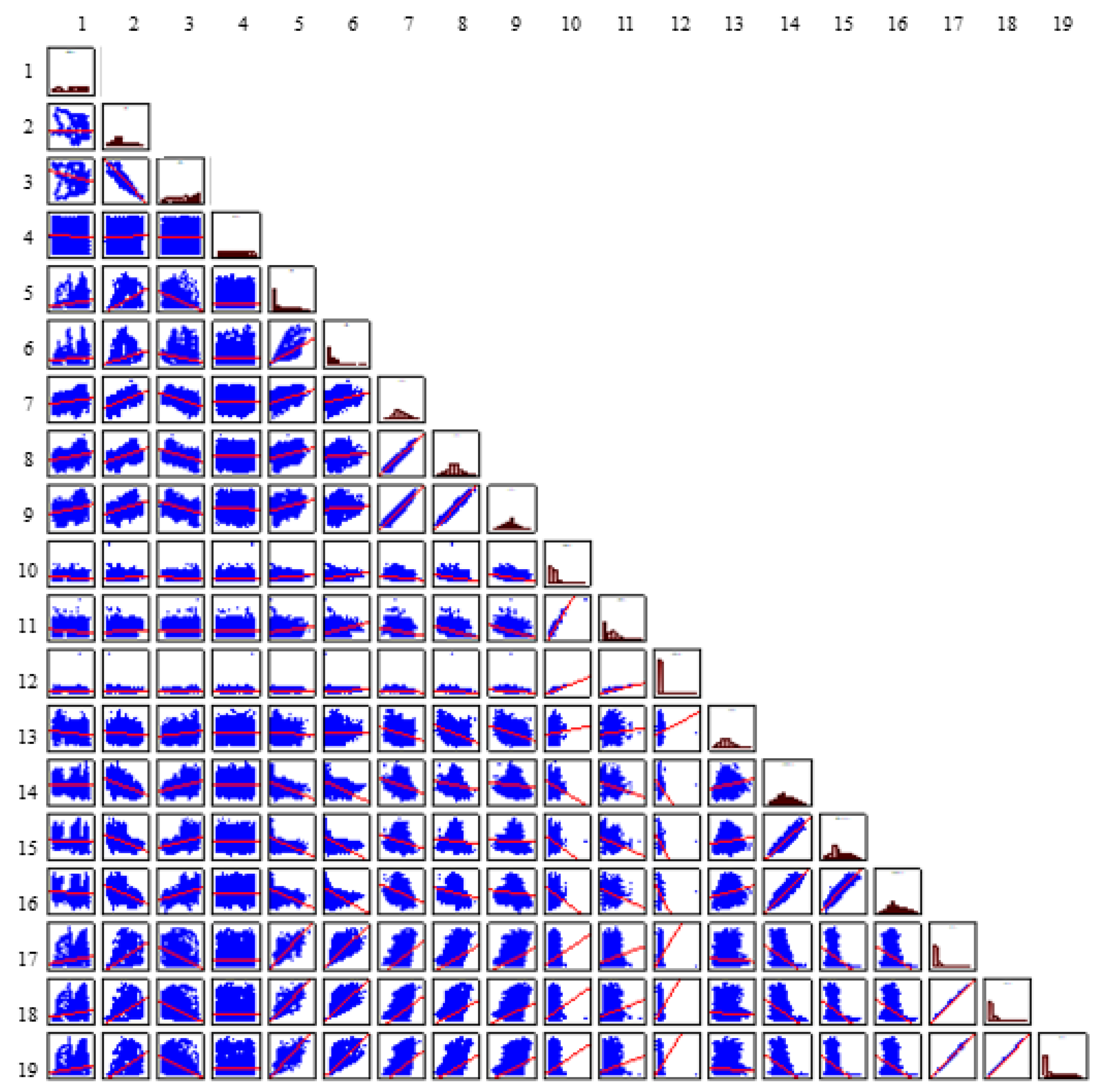
| Parameter | Symbol | Resolution | Acceptance Level | |
|---|---|---|---|---|
| Standard EN 50160:2010 [1] | Standard EN 50160:2015 [2] | |||
| Frequency variation | f | 10 s | 49.5 to 50.5 Hz for 99.5% of measurement data set, | 49.9 to 50.1 Hz for 100% of measurement data set |
| 47 to 52 Hz for 100% of measurement data set | ||||
| Voltage variation | U | 10 min | 90 to 110% Uref for 95% of measurement data set, | Not defined |
| 85 to 110% Uref for 100% of measurement data set | ||||
| 1 min | Not defined | 90 to 110% Uref for 100% of measurement data set | ||
| Flicker | Pst | 10 min | Not defined | 1.2 for 95% of measurement data set |
| Plt | 2 h | 1 for 95% of measurement data set | 1 for 100% of measurement data set | |
| Asymmetry | ku2 | 10 min | 2% for 95% of measurement data set, | 2% for 100% of measurement data set |
| 3% in special localization | ||||
| Total harmonic distortion in voltage | THDu | 10 min | 8% for 95% of measurement data set | 8% for 100% of measurement data set, |
| Mean value from all period of time lower than 5% | ||||
| Harmonic h2–h50 | h2–h50 | 10 min | for 95% of measurement data set: | for 100% measurement data set: |
| 6.0% for h5; | 6.0% for h5; | |||
| 5.0% for h3, h7; | 5.0% for h3, h7; | |||
| 3.5% for h11; | 3.5% for h11; | |||
| 3.0% for h13; | 3.0% for h13; | |||
| 2.0% for h2, h17; | 2.0% for h2, h17; | |||
| 1.5% for h9, h19, h23, h25; | 1.5% for h9, h19, h23, h25; | |||
| 1.0% for h4, | 1.0% for h4, h29, h31, h35, h37, h41, h43, h47, h49; | |||
| 0.5% for h6, h8, h10, h12, h14, h15, h16, h18, h20, h21, h22, h24. | 0.5% for h6, h8, h10, h12, h14, h15, h16, h18, h20, h21, h22, h24, h26, h27, h28, h30, h32, h33, h34, h36, h38, h39, h40, h42, h44, h45, h46, h48, h50. | |||
| Parameter | EN 50160:2010 [1] | EN 50160:2015 [2] | Comments |
|---|---|---|---|
| f | ✓ | ✖ | Maximum frequency value 50.103 Hz |
| U | ✓ | ✓ | - |
| Pst | - | ✓ | Single values exceeded but for less than 95% of the time |
| Plt | ✓ | ✓ | - |
| ku2 | ✓ | ✓ | - |
| THDu | ✓ | ✓ | - |
| h2-h14 | ✓ | ✓ | - |
| h15 | ✓ | ✖ | h15 maximum value for L3 is 0.51 % |
| h16-h25 | ✓ | ✓ | - |
| h26-h50 | - | ✓ | - |
| Voltage Variations Parameters | 1 Min Aggregation | 10 Min Aggregation | ||||
|---|---|---|---|---|---|---|
| L1 | L2 | L3 | L1 | L2 | L3 | |
| Mean value | 240.12 | 238.83 | 239.63 | 240.12 | 238.83 | 239.63 |
| Minimal value | 232.83 | 230.01 | 231.38 | 234.00 | 230.81 | 232.73 |
| Maximal value | 248.44 | 249.90 | 248.30 | 246.10 | 246.53 | 247.31 |
| Variation | 5.81 | 8.98 | 8.10 | 5.54 | 8.58 | 7.67 |
| Standard deviation | 2.41 | 3.00 | 2.85 | 2.35 | 2.93 | 2.77 |
| Median value | 239.86 | 238.88 | 239.60 | 239.85 | 238.85 | 239.61 |
| Positive Correlation | Negative Correlation | Correlation Level Description |
|---|---|---|
| No correlation | ||
| 0.1 | Slight correlation | |
| 0.4 | Poor correlation | |
| 0.7 | Noticeable correlation | |
| 0.9 | High correlation | |
| Strong correlation |
| 1 | 2 | 3 | 4 | 5 | 6 | 7 | 8 | 9 | 10 | 11 | 12 | 13 | 14 | 15 | 16 | 17 | 18 | 19 | |
|---|---|---|---|---|---|---|---|---|---|---|---|---|---|---|---|---|---|---|---|
| 1 | 1.00 | ||||||||||||||||||
| 2 | −0.01 | 1.00 | |||||||||||||||||
| 3 | −0.26 | −0.85 | 1.00 | ||||||||||||||||
| 4 | −0.01 | 0.01 | 0.00 | 1.00 | |||||||||||||||
| 5 | 0.21 | 0.63 | −0.61 | 0.00 | 1.00 | ||||||||||||||
| 6 | 0.12 | 0.40 | −0.34 | 0.00 | 0.71 | 1.00 | |||||||||||||
| 7 | 0.29 | 0.62 | −0.60 | −0.01 | 0.46 | 0.27 | 1.00 | ||||||||||||
| 8 | 0.35 | 0.48 | −0.53 | −0.02 | 0.34 | 0.10 | 0.95 | 1.00 | |||||||||||
| 9 | 0.37 | 0.43 | −0.48 | −0.02 | 0.32 | 0.05 | 0.90 | 0.96 | 1.00 | ||||||||||
| 10 | −0.23 | 0.14 | −0.03 | 0.01 | 0.30 | 0.44 | −0.25 | −0.41 | −0.47 | 1.00 | |||||||||
| 11 | −0.24 | 0.14 | −0.03 | 0.01 | 0.28 | 0.41 | −0.26 | −0.41 | −0.47 | 0.98 | 1.00 | ||||||||
| 12 | −0.20 | 0.11 | −0.02 | 0.03 | 0.27 | 0.41 | −0.23 | −0.37 | −0.44 | 0.93 | 0.89 | 1.00 | |||||||
| 13 | −0.24 | −0.15 | 0.27 | −0.02 | −0.06 | 0.06 | −0.39 | −0.50 | −0.45 | 0.20 | 0.21 | 0.16 | 1.00 | ||||||
| 14 | −0.01 | −0.55 | 0.44 | −0.02 | −0.54 | −0.52 | −0.35 | −0.22 | −0.13 | −0.40 | −0.39 | −0.37 | 0.24 | 1.00 | |||||
| 15 | −0.06 | −0.52 | 0.42 | −0.03 | −0.58 | −0.59 | −0.29 | −0.13 | −0.06 | −0.49 | −0.48 | −0.46 | 0.16 | 0.93 | 1.00 | ||||
| 16 | −0.05 | −0.53 | 0.45 | −0.01 | −0.54 | −0.57 | −0.37 | −0.21 | −0.12 | −0.44 | −0.43 | −0.41 | 0.22 | 0.91 | 0.95 | 1.00 | |||
| 17 | 0.20 | 0.63 | −0.60 | 0.00 | 0.99 | 0.70 | 0.48 | 0.35 | 0.34 | 0.29 | 0.27 | 0.26 | −0.04 | −0.53 | −0.56 | −0.52 | 1.00 | ||
| 18 | 0.20 | 0.62 | −0.59 | 0.01 | 0.99 | 0.72 | 0.47 | 0.34 | 0.32 | 0.31 | 0.29 | 0.28 | −0.05 | −0.56 | −0.59 | −0.55 | 1.00 | 1.00 | |
| 19 | 0.20 | 0.62 | −0.60 | 0.00 | 0.99 | 0.70 | 0.48 | 0.36 | 0.34 | 0.28 | 0.26 | 0.25 | −0.04 | −0.53 | −0.56 | −0.52 | 1.00 | 1.00 | 1.00 |
| 1 | 2 | 3 | 4 | 5 | 6 | 7 | 8 | 9 | 10 | 11 | 12 | 13 | 14 | 15 | 16 | 17 | 18 | 19 | |
|---|---|---|---|---|---|---|---|---|---|---|---|---|---|---|---|---|---|---|---|
| 1 | 1.00 | ||||||||||||||||||
| 2 | −0.01 | 1.00 | |||||||||||||||||
| 3 | −0.26 | −0.85 | 1.00 | ||||||||||||||||
| 4 | −0.01 | 0.01 | 0.00 | 1.00 | |||||||||||||||
| 5 | 0.20 | 0.60 | −0.59 | 0.00 | 1.00 | ||||||||||||||
| 6 | 0.12 | 0.39 | −0.34 | 0.00 | 0.69 | 1.00 | |||||||||||||
| 7 | 0.28 | 0.60 | −0.58 | −0.01 | 0.46 | 0.27 | 1.00 | ||||||||||||
| 8 | 0.35 | 0.47 | −0.51 | −0.02 | 0.35 | 0.11 | 0.95 | 1.00 | |||||||||||
| 9 | 0.36 | 0.41 | −0.47 | −0.02 | 0.33 | 0.06 | 0.90 | 0.96 | 1.00 | ||||||||||
| 10 | −0.17 | 0.10 | −0.03 | 0.02 | 0.23 | 0.34 | −0.20 | −0.31 | −0.34 | 1.00 | |||||||||
| 11 | −0.18 | 0.09 | −0.01 | 0.02 | 0.21 | 0.32 | −0.21 | −0.32 | −0.36 | 0.98 | 1.00 | ||||||||
| 12 | −0.17 | 0.09 | −0.02 | 0.02 | 0.23 | 0.34 | −0.20 | −0.31 | −0.35 | 0.95 | 0.94 | 1.00 | |||||||
| 13 | −0.22 | −0.14 | 0.25 | −0.01 | −0.05 | 0.04 | −0.32 | −0.44 | −0.38 | 0.11 | 0.13 | 0.12 | 1.00 | ||||||
| 14 | −0.02 | −0.52 | 0.41 | −0.02 | −0.50 | −0.48 | −0.31 | −0.19 | −0.11 | −0.29 | −0.28 | −0.29 | 0.21 | 1.00 | |||||
| 15 | −0.06 | −0.50 | 0.40 | −0.02 | −0.54 | −0.56 | −0.27 | −0.11 | −0.05 | −0.35 | −0.34 | −0.35 | 0.14 | 0.91 | 1.00 | ||||
| 16 | −0.05 | −0.52 | 0.43 | −0.01 | −0.50 | −0.55 | −0.35 | −0.19 | −0.11 | −0.32 | −0.31 | −0.33 | 0.20 | 0.88 | 0.93 | 1.00 | |||
| 17 | 0.20 | 0.60 | −0.58 | 0.00 | 0.97 | 0.69 | 0.48 | 0.37 | 0.35 | 0.22 | 0.21 | 0.22 | −0.04 | −0.49 | −0.53 | −0.49 | 1.00 | ||
| 18 | 0.19 | 0.60 | −0.57 | 0.00 | 0.97 | 0.70 | 0.48 | 0.36 | 0.34 | 0.24 | 0.22 | 0.23 | −0.04 | −0.51 | −0.56 | −0.52 | 1.00 | 1.00 | |
| 19 | 0.20 | 0.60 | −0.58 | 0.00 | 0.97 | 0.69 | 0.49 | 0.37 | 0.36 | 0.22 | 0.20 | 0.22 | −0.04 | −0.49 | −0.52 | −0.49 | 1.00 | 1.00 | 1.00 |
| 1 | 2 | 3 | 4 | 5 | 6 | 7 | 8 | 9 | 10 | 11 | 12 | 13 | 14 | 15 | 16 | 17 | 18 | 19 | |
|---|---|---|---|---|---|---|---|---|---|---|---|---|---|---|---|---|---|---|---|
| 1 | 0.00 | ||||||||||||||||||
| 2 | 0.00 | 0.00 | |||||||||||||||||
| 3 | 0.00 | 0.00 | 0.00 | ||||||||||||||||
| 4 | 0.00 | 0.00 | 0.00 | 0.00 | |||||||||||||||
| 5 | 0.01 | 0.02 | 0.02 | 0.00 | 0.00 | ||||||||||||||
| 6 | 0.00 | 0.00 | 0.00 | 0.00 | 0.02 | 0.00 | |||||||||||||
| 7 | 0.01 | 0.02 | 0.02 | 0.00 | 0.00 | 0.00 | 0.00 | ||||||||||||
| 8 | 0.01 | 0.01 | 0.01 | 0.00 | −0.01 | 0.00 | 0.00 | 0.00 | |||||||||||
| 9 | 0.01 | 0.01 | 0.02 | 0.00 | −0.01 | −0.01 | 0.00 | 0.01 | 0.00 | ||||||||||
| 10 | 0.06 | 0.04 | 0.01 | 0.00 | 0.07 | 0.10 | 0.05 | 0.10 | 0.12 | 0.00 | |||||||||
| 11 | 0.06 | 0.05 | 0.02 | 0.00 | 0.07 | 0.09 | 0.04 | 0.09 | 0.12 | 0.00 | 0.00 | ||||||||
| 12 | 0.03 | 0.02 | 0.00 | 0.01 | 0.04 | 0.07 | 0.03 | 0.06 | 0.08 | −0.02 | −0.05 | 0.00 | |||||||
| 13 | 0.03 | 0.01 | 0.02 | 0.01 | 0.00 | 0.02 | 0.06 | 0.06 | 0.07 | 0.09 | 0.08 | 0.04 | 0.00 | ||||||
| 14 | 0.00 | 0.03 | 0.02 | 0.00 | 0.05 | 0.03 | 0.04 | 0.03 | 0.02 | 0.11 | 0.12 | 0.09 | 0.03 | 0.00 | |||||
| 15 | 0.00 | 0.02 | 0.01 | 0.01 | 0.04 | 0.03 | 0.02 | 0.02 | 0.01 | 0.15 | 0.15 | 0.11 | 0.02 | 0.02 | 0.00 | ||||
| 16 | 0.00 | 0.01 | 0.01 | 0.00 | 0.04 | 0.02 | 0.02 | 0.01 | 0.01 | 0.12 | 0.12 | 0.08 | 0.02 | 0.03 | 0.02 | 0.00 | |||
| 17 | 0.01 | 0.02 | 0.02 | 0.00 | 0.02 | 0.02 | −0.01 | −0.01 | −0.02 | 0.06 | 0.06 | 0.04 | 0.01 | 0.04 | 0.03 | 0.03 | 0.00 | ||
| 18 | 0.01 | 0.02 | 0.02 | 0.00 | 0.02 | 0.02 | −0.01 | −0.02 | −0.02 | 0.07 | 0.07 | 0.05 | 0.01 | 0.04 | 0.04 | 0.03 | 0.00 | 0.00 | |
| 19 | 0.01 | 0.02 | 0.02 | 0.00 | 0.02 | 0.02 | −0.01 | −0.01 | −0.02 | 0.06 | 0.06 | 0.04 | 0.01 | 0.04 | 0.03 | 0.03 | 0.00 | 0.00 | 0.00 |
© 2019 by the authors. Licensee MDPI, Basel, Switzerland. This article is an open access article distributed under the terms and conditions of the Creative Commons Attribution (CC BY) license (http://creativecommons.org/licenses/by/4.0/).
Share and Cite
Jasiński, M.; Sikorski, T.; Kostyła, P.; Kaczorowska, D.; Leonowicz, Z.; Rezmer, J.; Szymańda, J.; Janik, P.; Bejmert, D.; Rybiański, M.; et al. Influence of Measurement Aggregation Algorithms on Power Quality Assessment and Correlation Analysis in Electrical Power Network with PV Power Plant. Energies 2019, 12, 3547. https://doi.org/10.3390/en12183547
Jasiński M, Sikorski T, Kostyła P, Kaczorowska D, Leonowicz Z, Rezmer J, Szymańda J, Janik P, Bejmert D, Rybiański M, et al. Influence of Measurement Aggregation Algorithms on Power Quality Assessment and Correlation Analysis in Electrical Power Network with PV Power Plant. Energies. 2019; 12(18):3547. https://doi.org/10.3390/en12183547
Chicago/Turabian StyleJasiński, Michał, Tomasz Sikorski, Paweł Kostyła, Dominika Kaczorowska, Zbigniew Leonowicz, Jacek Rezmer, Jarosław Szymańda, Przemysław Janik, Daniel Bejmert, Marek Rybiański, and et al. 2019. "Influence of Measurement Aggregation Algorithms on Power Quality Assessment and Correlation Analysis in Electrical Power Network with PV Power Plant" Energies 12, no. 18: 3547. https://doi.org/10.3390/en12183547
APA StyleJasiński, M., Sikorski, T., Kostyła, P., Kaczorowska, D., Leonowicz, Z., Rezmer, J., Szymańda, J., Janik, P., Bejmert, D., Rybiański, M., & Jasińska, E. (2019). Influence of Measurement Aggregation Algorithms on Power Quality Assessment and Correlation Analysis in Electrical Power Network with PV Power Plant. Energies, 12(18), 3547. https://doi.org/10.3390/en12183547









